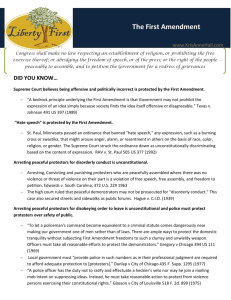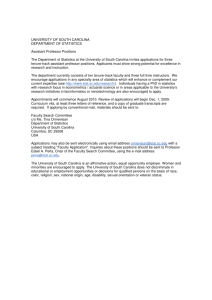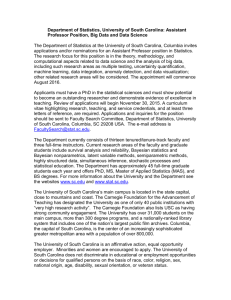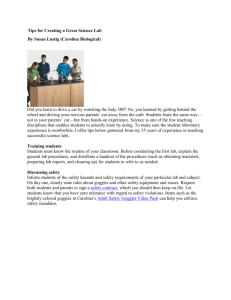Edwards v. South Carolina
advertisement
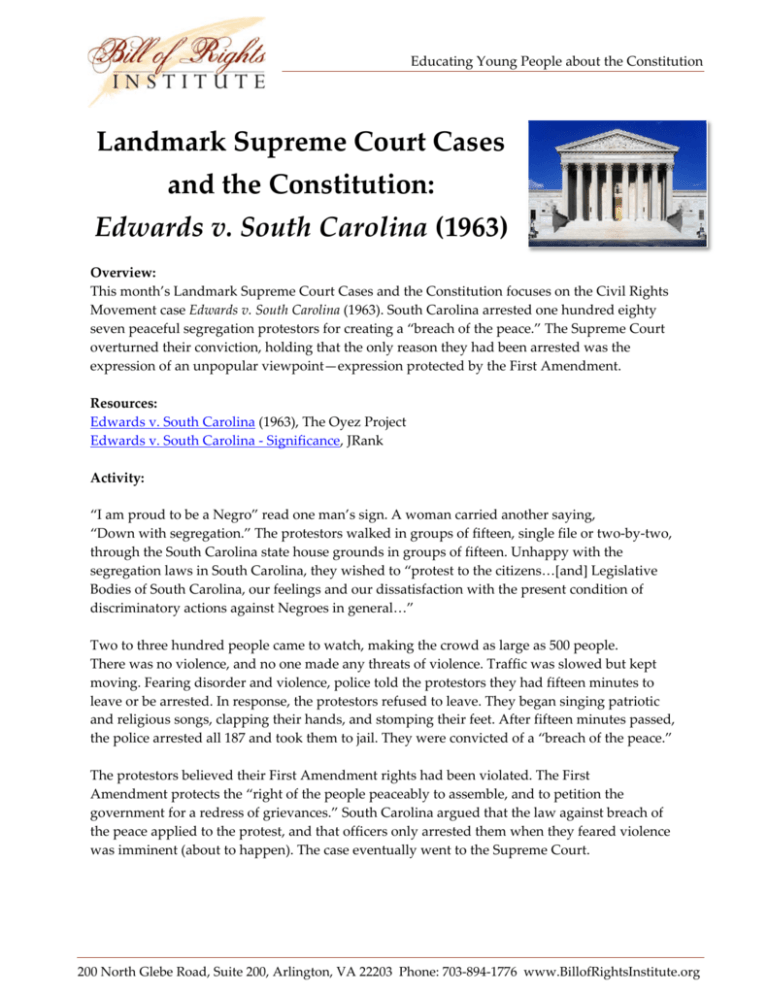
Educating Young People about the Constitution Landmark Supreme Court Cases and the Constitution: Edwards v. South Carolina (1963) Overview: This month’s Landmark Supreme Court Cases and the Constitution focuses on the Civil Rights Movement case Edwards v. South Carolina (1963). South Carolina arrested one hundred eighty seven peaceful segregation protestors for creating a “breach of the peace.” The Supreme Court overturned their conviction, holding that the only reason they had been arrested was the expression of an unpopular viewpoint—expression protected by the First Amendment. Resources: Edwards v. South Carolina (1963), The Oyez Project Edwards v. South Carolina ‐ Significance, JRank Activity: “I am proud to be a Negro” read one man’s sign. A woman carried another saying, “Down with segregation.” The protestors walked in groups of fifteen, single file or two‐by‐two, through the South Carolina state house grounds in groups of fifteen. Unhappy with the segregation laws in South Carolina, they wished to “protest to the citizens…[and] Legislative Bodies of South Carolina, our feelings and our dissatisfaction with the present condition of discriminatory actions against Negroes in general…” Two to three hundred people came to watch, making the crowd as large as 500 people. There was no violence, and no one made any threats of violence. Traffic was slowed but kept moving. Fearing disorder and violence, police told the protestors they had fifteen minutes to leave or be arrested. In response, the protestors refused to leave. They began singing patriotic and religious songs, clapping their hands, and stomping their feet. After fifteen minutes passed, the police arrested all 187 and took them to jail. They were convicted of a “breach of the peace.” The protestors believed their First Amendment rights had been violated. The First Amendment protects the “right of the people peaceably to assemble, and to petition the government for a redress of grievances.” South Carolina argued that the law against breach of the peace applied to the protest, and that officers only arrested them when they feared violence was imminent (about to happen). The case eventually went to the Supreme Court. 200 North Glebe Road, Suite 200, Arlington, VA 22203 Phone: 703‐894‐1776 www.BillofRightsInstitute.org Educating Young People about the Constitution The Supreme Court ruled for the protestors and overturned their convictions. The Court held that South Carolina had violated the protestors’ First Amendment rights to peaceful expression, assembly, and petition. These rights applied to the states through the Fourteenth Amendment’s due Process Clause. The Court emphasized that the protest had been peaceful and law‐abiding. “If…the petitioners had…violated a law regulating traffic, or had disobeyed a law reasonably limiting the periods during which the State House grounds were open to the public, this would be a different case.” Rather, they had been arrested and convicted for expression unpopular views. The evidence “showed no more than that the opinions which they were peaceably expressing were sufficiently opposed to the views of the majority of the community to attract a crowd and necessitate police protection…. The Fourteenth Amendment does not permit a State to make criminal the peaceful expression of unpopular views.” Discussion Questions: 1. Why did 187 protestors gather at the South Carolina State House in this case? 2. What did police tell the protestors, and how did they react? 3. How did the Supreme Court rule in Edwards v. South Carolina (1963)? Do you believe the ruling was correct? 4. Dissenting in the case, Justice Clark argued, “The question…seems to me whether a State is constitutionally prohibited from enforcing laws to prevent breach of the peace in a situation where city officials in good faith believe, and the record shows, that disorder and violence are imminent, merely because the activities constituting that breach contain claimed elements of constitutionally protected speech and assembly. To me, the answer under our cases is clearly in the negative.” Do you agree with his assessment of the case? Why or why not? Extension: Have students select one quotation from the list below and write two or three paragraphs explaining how it illustrates the significance of the First Amendment. “Speech is often provocative and challenging. It may strike at prejudices and preconceptions, and have profound unsettling effects as it presses for acceptance of an idea. That is why freedom of speech . . . is . . . protected against censorship or punishment, unless shown likely to produce a clear and present danger of a serious substantive evil that rises far above public inconvenience, annoyance, or unrest.” Terminiello v. Chicago (1949) The maintenance of the opportunity for free political discussion to the end that government may be responsive to the will of the people and that changes may be obtained by lawful means, Educating Young People about the Constitution an opportunity essential to the security of the Republic, is a fundamental principle of our constitutional system. Stromberg v. California (1931) We are not afraid to entrust the American people with unpleasant facts, foreign ideas, alien philosophies, and competitive values. For a nation that is afraid to let its people judge the truth and falsehood in an open market is a nation that is afraid of its people. – President John F. Kennedy, 1963 The First Amendment is often inconvenient. But that is beside the point. Inconvenience does not absolve the government of its obligation to tolerate speech –Supreme Court Justice Anthony Kennedy, 1992 Without freedom of thought there can be no such thing as wisdom; and no such thing as public liberty without freedom of speech. –Benjamin Franklin, 1722
